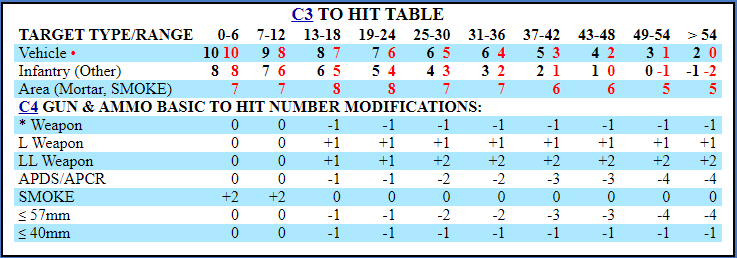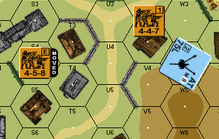Note: This article originally appeared in Banzai!! Newsletter, Volume 26, Number 1. This is a lightly edited version of the same article removing typos in the original article.
Introduction
Newer players tend to count all the DRMs and add them into the To Hit Number (TH#). For instance, you’re firing your Gun at an Infantry unit in a stone building adjacent to the Gun’s Location. Players see a Base TH# of 8, +3 TEM for the stone building, -2 for Point Blank Range and say something like “I need a 7 to hit”. While this may get the dice roll (DR) you need it makes calculating a Critical Hit (CH) more problematic. In this article we will examine Infantry Target Type and how to calculate CHs. Let’s get stuck in.
What is a CH? C3.7 says it is a hit so well placed it increases the chances of causing damage. To achieve one using ITT your Final TH DR must be less than HALF of the Modified TH#. But what are the Final TH DR and Modified TH#?

To determine the Modified TH#, take the Base TH# found on the C3 To Hit Table and cross-reference the Gun’s barrel length and caliber with the range on the C4 table. This yields a modifier applicable to the Base TH#. For instance, suppose we are firing a German 75L Gun at a target 13 hexes away. Using ITT, the Base TH# is 6. The “L” gun adds a +1 for a Modified TH# of 7. There is no modifier for ammo/caliber size. Note the modifiers for small-caliber Guns are cumulative. A 28mm Gun using ITT at 19 hexes would have a -2 modifier applied. A -1 for less than or equal to 57mm and -1 for less than or equal to 40mm. The end result is a Modified TH# of 3.
To determine the Final TH DR we roll the dice–the Original TH DR– and add all applicable DRMs to the DR. For instance, if the total TH DRM is +1 a roll of (2,1) yields a Final TH DR of 4. This Final TH DR is compared to the Modified TH# to determine if a CH results.
Let’s look at a couple of examples.
Examples

EX 1: The 75L wishes to shoot at the adjacent 4-4-7. The 4-4-7 occupies a wooden building. Looking at the C3 table for ITT we see the Base TH# is 8. Looking at C4 there are no barrel or size modifiers so the Modified TH# is 8. A CH occurs on a Final TH DR less than half of 8 (4). There is a +2 DRM for TEM and a -2 DRM for Case L. The Final TH DRM is zero. As such, the Final TH DR will equal the Original TH DR (what we actually roll on the dice). A CH occurs on a DR of 3 or less. A normal hit occurs on a DR of 4 through 8. The Gun misses altogether on any roll of 9 or greater.
EX 2: Refer to the image above. In this example the 4-5-8 is using Non-Assault Movement (FFNAM) through Open Ground (FFMO) for a total -2 DRM. Looking at C3 Table for ITT, the Base TH# is again 8. Looking at C4 we see there are no modifiers so the Modified TH# is an 8. We already know a CH occurs on a Final DR less than half of the Modified TH# (less than 4). We will subtract 2 from the Original TH DR to get the Final TH DR. A CH occurs on a DR of 5 or less (5 – 2 = 3, 3 < 4). A normal hit will occur on a 6 through 10 (10 -2 equals the Final TH# of 8). The Gun completely misses on an 11 or greater.

EX 3: For our last example we will use the image above. The Gun fires at the 6-2-8 in G4. The range is 16 hexes. The Base TH# for ITT at 16 hexes is 6. Cross-referencing the range with the barrel length (“L” Gun) and caliber (75mm) adds a +1 to the Base TH# . There are no other modifiers so the Modified TH# is 7. To achieve a CH a Final TH DR of < half of 7, or 3.5, is needed. Notice C3.7 does not round fractions in this calculation.
Returning to the example, the Gun fires on the 6-2-8. The Modified TH# is a 7. With no TH DRM. The Original TH DR is the Final TH DR. A CH occurs on a DR of 3 or less (3 is less than 3.5). A normal hit occurs on a 7 or less. The Gun misses altogether on anything 8 or greater.
Now imagine the 6-2-8 is moving and FFNAM/FFMO are applicable. The Modified TH# remains a 7. This time a -2 DRM applies to the Original TH DR to get the Final TH DR. A CH occurs on a 5 or less (5 – 2 = 3, 3 is less than 3.5). A normal hit occurs on a 9 or less. The Gun misses on a 10 or greater.
Now imagine if you calculated this last example as suggested in paragraph one. The Modified TH# is 7, hitting on a 9. You roll a 5 which is not less than 3.5 (half of 7) so you think no CH. I have seen this scenario play out countless times. I urge you not to do this. Keep the Modified TH# and final TH DRMs separate. Rather than say “Hit on a 9”, instead say “7 to hit with a -2 DRM”. I personally call out “7 -2 To Hit”. When you roll the dice–say you roll a 5– you’ll begin to automatically subtract the DRM to get a Final TH DR. In this case, a Final TH DR of 3 which IS < half of 7. Also note the impact of the “L” Gun here. Had the 75L not been an “L” Gun, the Modified TH# would have been 6 yielding a CH on a Final TH DR < 3. A CH could only happen on a Final TH DR of 2 or less. This requires an Original TH DR of 4 or less when the -2 DRM is applied.
There is another case when an ITT CH can occur. If your Original TH DR is a 1,1 it is still possible to score a CH even if your Final TH DR is greater than half the Modified TH#. Make a subsequent dr (one die). If the dr is less than or equal to half the Modified TH#, a CH occurs. Image a Gun 3 hexes from an Infantry unit in a stone building. The Modified TH# is 8 with a +3 DRM. An Original TH DR of 1,1 is rolled. The Final TH DR is 5 and not less than half of 8. On a subsequent dr of 1 through 4 a CH occurs. There are some exceptions to this (see C3.6).
To this point we have only spoken about how CHs are achieved. When it comes to resolving them, please examine C3.71. If the target Location contains multiple eligible targets Random Selection also applies (C3.74). A Gun and its manning crew are eliminated if they are hit by a CH regardless of the effects DR (C11.4).
Conclusion
Calling out the Modified TH# in combination with the final TH DRM makes calculating Infantry Target Type Critical Hits easier. To achieve a Critical Hit, the Final TH DR must be less than half of the Modified TH#. Fractions remain un-rounded when calculating the Final TH DR needed to achieve a Critical Hit. A 1,1 is not ALWAYS a CH when using the Infantry Target Type. It usually gives a chance to score a CH even if the Final TH DR is too big. On a 1,1, a subsequent dr of less than or equal to half the Modified To Hit# is a CH. It is also worth noting the only time “less than or equal” applies is on the subsequent dr used when rolling a 1,1. At all other times it is less than half.
I hope you found this article helpful. If you have corrections please don’t hesitate to let me know. — jim
This article originally appeared in Banzai!!, Volume 26, Number 1. This is an excellent Newsletter offered by the Texas ASL community.

